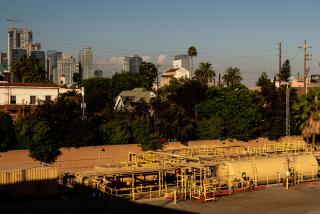It’s Not Crude Living When Roughnecks Land on the Islands
- Share via
Peter Kawiak arrives at work like a man taking a Caribbean cruise. He steps off a boat onto an island graced by swaying palm trees. A roaring waterfall, visible from the mainland, is lighted every night here, like the jewel of some exotic lagoon.
This is no tourist play land, however. Toiling through a 12-hour shift, Kawiak is soon a graphic reminder of that. His clothes, his helmet, even his eyeglasses are spattered tobacco-brown with mud. Like the other roughnecks in his drilling crew--and like the island itself--the 37-year-old Kawiak is here for only one reason: to recover crude oil from beneath the ocean floor.
Behind its tropical facade, Island White, one of four man-made islands off the Long Beach coast, is a Rube Goldberg array of concealed tanks, pumps, pipes and drilling rigs--more Alcatraz than Tahiti. Yet the crews that work here, laboring around the clock to drill and maintain about 250 offshore wells, consider the island a sort of driller’s paradise. It is a tiny archipelago of stability in a profession dominated by booms, busts and the wild mood swings of the international oil market.
“The islands are great because you don’t have to chase the rig around,” said Kawiak, who used to typify the nomadic lifestyle of roughnecks just about everywhere. Over 14 years, the lanky “derrick man” worked just about every California oil field between Fresno and El Centro. When the drilling stopped one place, the rig--and Kawiak--moved on.
Now, after more than a year on the island, he is a little spoiled. “I’m a fair-weather roughneck,” Kawiak said with a laugh. “I won’t work where a palm tree won’t grow.”
Creating the oil islands was a huge gamble undertaken in the 1960s by Long Beach, the state and a consortium of major oil companies.
The aim was to tap portions of the vast Wilmington oil field, the fourth-largest ever discovered in the United States. With the blessing of city voters, an unprecedented agreement was reached by which five companies--Texaco, Humble (Exxon), Unocal, Mobil and Shell--contributed equally to build the four, 10-acre islands. An independent company, THUMS, was established, and more than 95% of all net profits were guaranteed to go back to the state and city.
Constructing the islands was an immense task for which the companies put up $250 million, said THUMS spokesman Steve Marsh. Rock was quarried on Catalina Island and moved into place by barge. Engineers studied myriad ways to make the islands environmentally safe and aesthetically pleasing.
Drilling rigs nearly 200 feet tall were enclosed in four-sided towers and lighted at night; tourists driving on the coast would later confuse them for offshore condominium developments. Waterfalls were built, running on seawater. Palms were planted--more than 720 of them. A regular survey by the city ensures that any dead or broken tree is replaced.
“If it’s an 85-foot palm tree” that dies, Marsh boasted, “we go get an 85-foot palm tree.”
In a state where offshore oil drilling remains a hotly debated environmental issue, the islands have been heralded as examples of how to do it right. At the height of conflict over one proposed statewide moratorium a few years ago, then-Gov. George Deukmejian, a supporter of offshore wells, told reporters that the islands “have been operating here for years and years and years with no damage. In fact, (Long Beach) is thriving more now than it ever has.”
That argument is very misleading, argues Lisa Weil of the American Oceans Campaign, an environmental group that is trying to strengthen a federal moratorium on new offshore drilling sites in California. With huge volumes of oil being pumped from the islands to the mainland via underwater pipelines, the possibility of “a situation like the Exxon Valdez” spill is ever-present, Weil said.
“I don’t think we should have a false sense of security,” she said, “just because it hasn’t happened yet.”
A lesser debate--are they beautiful?--also dogs the islands. A few critics say they are too artificial, too much like some offshore movie set. On the other hand, one resident, on the eve of her Christmas party, wanted the islands’ holiday lights turned on in time to be seen from her window. And last year, March said, a couple getting married at sea took great pains to arrange to have one of the waterfalls activated a few hours early, providing a scenic backdrop.
J.D. Potts, who started on the islands in 1966, is one of the old-timers now, a tobacco chewer who got his start on the vast oil plains of New Mexico. The 55-year-old drilling supervisor remembered times when he got off a 12-hour shift, drove half the night to another rig, and began another shift.
“A 150-mile drive wasn’t nothing” in New Mexico, Potts said. And when the weather turned bad, the crew could get snowed in for days. “We’d be running out of things to eat,” he said, “and we’d go running down rabbits in the snow. . . . Catch them, skin them, ice them down.”
He came West for temporary work, but the islands captured him. “I’ve been out here, I guess, longer than anybody,” Potts said. “It’s been a lot of boat rides.”
More to Read
Sign up for Essential California
The most important California stories and recommendations in your inbox every morning.
You may occasionally receive promotional content from the Los Angeles Times.










